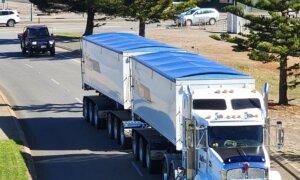The Albanese government’s decision to shut down the live sheep export will cost rural communities in Western Australia millions of dollars over the next decade, a farmer advocacy group has warned.
The multi-billion dollar industry suffered a public relations blow in 2018, when Perth-based ship operator Emanuel Exports was charged with animal cruelty offences after it was reported that about 2,400 sheep died on board the Awassi Express.
While the charges were subsequently dropped by Perth prosecutors, the live sheep export trade never fully recovered from the public seeing footage of distressed and dead sheep on the ship.
Meanwhile, WA Farmers President John Hassell says the current decision by the federal government to phase out the practice altogether will have a negative ripple effect on regional economies.
He said his industry provided job security for many sheep-rearing families throughout the state.
“This will absolutely decimate—and I’m not using that word lightly—regional Western Australia,” he told The Epoch Times.
NEWROC represents seven local government areas, including Dowerin, Koorda, Mt Marshall, Mukinbudin, Nungarin, Trayning, and Wyalkatchem.
“It’s some pretty serious coin,” Mr. Hassel remarked.
Can the Sheep Industry Still Prosper?
Agriculture Minister Murray Watt, however, argues the sheep industry can still prosper without live exports.“The Australian sheep industry now has the time, support, and certainty it needs to plan effectively for the future,” Minister Watt said in a media release on May 30.
“All that would change is that the sheep would be processed onshore.”
Minister Watt added that live sheep exports had dropped significantly in the past two decades, while chilled and frozen exported Australian sheep meat numbers have gone up.
“While live sheep export numbers have plummeted in the last 20 years, now contributing just 0.1 percent of all national agricultural exports, sheep meat exports are going through the roof,” he said.
But Nationals Senator Matt Canavan accused the Agriculture Minister of downplaying the impact of the live sheep export ban on farmers, pointing to a government report that 14 percent indicated they would be forced to find new careers.
“The remaining $52 million represents funding primarily from government to government departments, agencies, and programs with at best indirect tangential benefit for the industry.”
Animal Welfare Groups Back Ban
Meanwhile, Animals Australia applauded the ban, saying that the global live export trade “has been built on an acceptance of suffering—sending animals on risky journeys halfway around the world just to be killed for their meat when they arrive in destination countries.”Rebecca Linigen from Four Paws Australia agreed, saying the live sheep export ban “aligns with modern community expectations on how animals should be treated, not just in Australia but on a global scale.”
The Royal Society for the Prevention of Cruelty to Animals (RSPCA) also issued a media release condemning the trade.
But How Are the Animals Coping?
However, WA Farmers CEO Trevor Whittington said sending higher numbers of sheep to Australia’s east coast from May 2028, would actually be more damaging from an animal welfare perspective.“It’s particularly damaging to WA because during the drought, which we’re currently seeing in the southwest corner, the only quick release for de-stocking is to put sheep on a boat and send them to the Middle East,” he told The Epoch Times.
“The activists are worried about animal welfare issues, but at the moment we’ve got 10 trucks a day going east on a 48-hour trip.
“I’d argue that you’d be better off putting those animals on a boat on welfare grounds alone.”
He warned that the cost of transporting livestock could also make business unviable.
Does it Stop at Sheep?
Mr. Whittington said the federal government could also face pressure from activist groups to shut down the cattle industry.“By weight and distance travelled by boat, cattle have a higher mortality rate than sheep,” Mr. Whittington said.
“The pressure will be on to shut down the cattle industry, but the government knows well there are too many marginal seats in New South Wales, Queensland and the Northern Territory at stake.”
“And there are too many Indigenous-owned cattle stations.”
The sentiment was echoed by Mr. Hassell, who said that the decision to ban live export could set a “terrible precedent.”
“What this [live sheep export ban] means is that any industry which anybody has a gripe with will be subject to a dirty little preference deal with any group who don’t like something that’s going on,” he said.
“That’s the challenge that we’ve got—this is setting a terrible precedent.”
A Protest Vote at the Next Election?
Mr. Hassell added that the majority of sheep farmers in WA would be voting for a change of government at the next federal election.“We’ll be calling for a motion of no-confidence in the Albanese government, we being the National Farmers Federation.”
On May 30, nearly 3,000 people and hundreds of livestock trucks descended on Perth’s CBD to protest the government’s decision.
Animals Australia and Minister Watt’s office were contacted for comment but a response was not received in time for publication.





